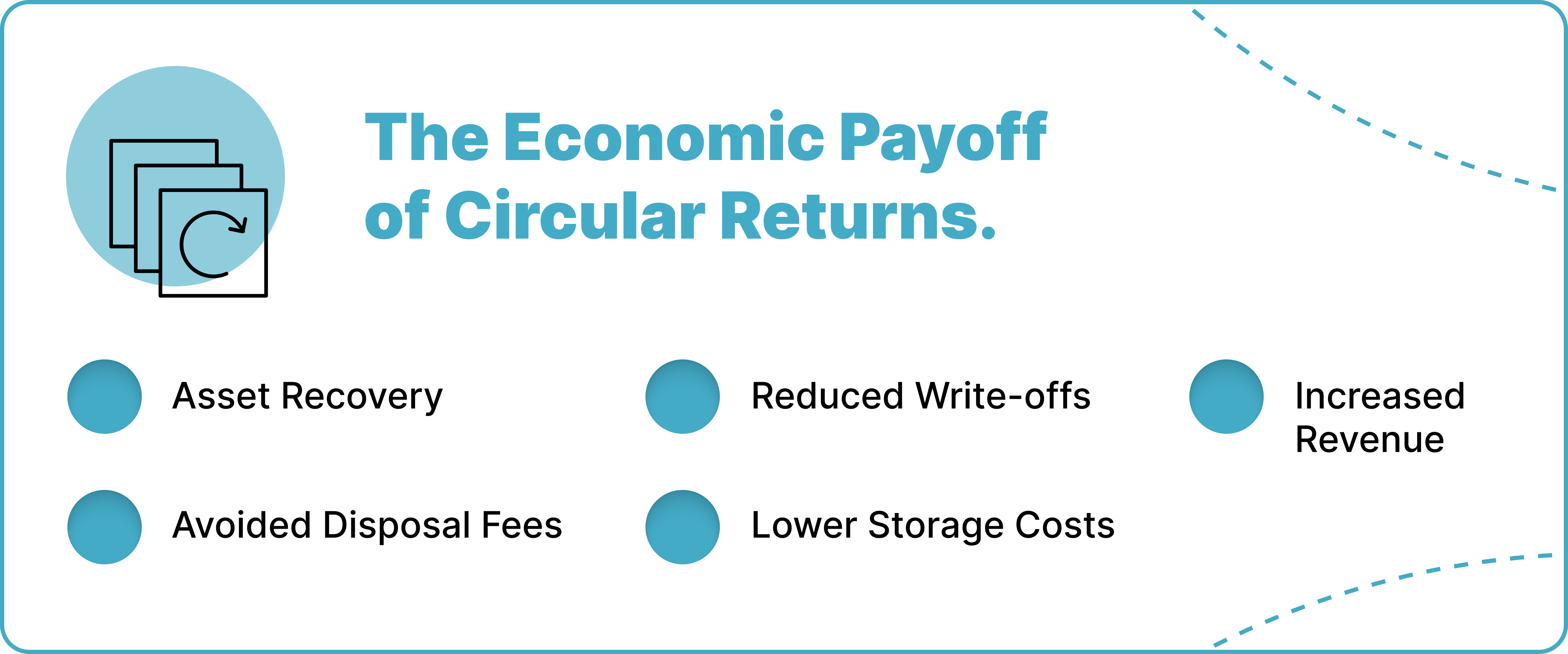The Business Case for Circular Returns Management

Returned goods cost businesses money. Storage, restocking, lost value, and shipping can quickly eat into your profits. Monitoring inventory levels can help prevent overstocking and understocking, optimize storage, and reduce costs. With global e-commerce growing and returns reaching 20% in some industries, these losses and logistics costs are likely to continue rising. However, circular returns can change that and help businesses cut costs and save money.
Instead of treating returns as waste, circular returns treat them as assets. Products are reused, refurbished, resold, or recycled. Optimizing product packaging in the returns process can further reduce waste and associated costs. By adopting this business model and incorporating sustainable practices, your team can reduce disposal and supply chain costs, generating measurable benefits and revenue growth within the business.
Circular returns are a cost-effective strategy for managing returns and improving profitability, while also reducing waste throughout the supply chain. And we are not discussing an abstract topic that may not make a difference. More brands are adopting circular strategies to build smarter supply chains that lower costs and increase recovery. Circular returns also help reduce logistics costs by streamlining the movement of returned goods.
So, What Are Circular Returns?
Circular returns focus on reuse, not waste. In a typical model, returns move from the customer to the warehouse, then to landfills. That’s linear. However, your business can leverage circular returns to enhance supply chain efficiency by moving products through loops, thereby reintegrating them into the economy. Optimizing the way products ship back to the warehouse can further improve efficiency and reduce logistics costs.
Here’s an example of how it works:
- An ecommerce retailer processes a return of a pair of shoes.
- It’s inspected and found to be lightly worn.
- Instead of getting tossed or buried in a pile, it’s cleaned, repackaged, and sold again at a discount.
That’s return merchandise value recovery, which directly affects the return on investment for businesses.
Brands use circular return models to create new revenue from returned stock. This way, they can lower their dependency on raw materials, reduce restocking time, and achieve significant financial returns while shrinking their waste footprint. Circular returns also help optimize storage space by moving goods quickly through the system, improving inventory management, and reducing warehousing costs. By adopting this returns management strategy, your business can establish green supply chain practices that enhance brand reputation, lead to sustainability ROI, save money, and contribute to a healthier planet.
More vital is the fact that your reverse supply chain becomes shorter, smarter, and more profitable.
The Economic Payoff of Circular Returns

Circular returns aren’t just greener. They’re leaner. If you think about it, many returns aren’t defective. Yes, they might be unwanted, the wrong size, or in some cases, opened but unused. However, these products still hold value, and throwing them away is an immense waste, especially in a world where more customers and stakeholders demand less waste and more sustainable strategies.
The circular return model can help your business capture that value before it disappears. Here is how it can improve your bottom line and overall financial performance:
- Asset Recovery: Components of damaged items can be reused or sold for parts.
- Avoided Disposal Fees: Circular processes avoid dumping charges and excess freight.
- Reduced Write-offs: Returned items can be repaired or sold as refurbished, not marked as a loss.
- Lower Storage Costs: Returns don’t sit idle. They move faster to resale or donation channels.
- Increased Revenue: Secondary markets create new income through refurbishment and resale programs.
- Volume Discounts: Businesses can leverage volume discounts when sourcing materials for refurbished products, reducing procurement expenses through bulk purchasing.
Consider a mid-market apparel brand that reroutes returns to an outlet resale channel. The cash savings alone can be significant, and then there is the efficiency from reduced warehouse overflow. Circular returns create a supply chain built to withstand market swings and margin pressure. Locating procurement sources near the manufacturing plant can further improve efficiency and reduce shipping costs.
Optimizing transportation costs is also a key part of the circular returns model, as consolidating shipments and choosing efficient logistics partners can minimize overall expenses.
To ensure ongoing improvement, it is important to conduct regular audits to identify strengths, weaknesses, and areas for enhancement in the circular returns process.
Brand Power: Circular Returns Build Loyalty

The fact is that sustainability is a significant trend in the current market. It sells. Buyers, especially younger ones, watch how brands handle waste, reflecting their increasing customer expectations for sustainability. They increasingly trust companies with values that match their own and support sustainability efforts, which translates to spending more on these brands. Circular returns can provide your business with a clear, visible way to demonstrate that it genuinely cares. Circular returns also enhance brand value by improving reputation and customer perception, making your brand stand out in a crowded market.
When a retailer resells refurbished electronics or donates unsold returns to non-profits, that story reaches customers. It improves trust and strengthens the brand.
- Public support: Circular economy initiatives drive social and environmental responsibility campaigns.
- Better engagement: Customers are more loyal to companies with waste reduction programs.
- Stronger margins: Brands with circular models reduce cost and boost their environmental image at the same time.
Retailers also future-proof their supply chains against new rules, and integrating sustainability into business practices is crucial for long-term success. Countries such as France, Germany, and Canada are introducing extended producer responsibility (EPR) laws that impose fines on companies for excessive waste. It is the companies with sustainable returns management, energy efficiency, and effective risk management already in place that ensure regulatory compliance and are ready for this shift. A company’s sustainability initiatives can also drive financial performance and attract investment, making the integration of sustainability into core business operations essential.
Environmental ROI Is Real
RReturned goods generate over 16 million metric tons of CO₂ emissions in the U.S. every year. More alarming is the fact that most of these returns are not resold. They are often discarded or burned as part of waste disposal practices, which only reinforces the view held by experts that returns don’t just incur financial costs, but also carry a carbon footprint. Fortunately, circular returns can slash that waste and minimize environmental impacts.
Here’s how:
- Products are refurbished instead of replaced.
- Materials are recycled instead of being discarded, optimizing resource use to minimize costs and waste.
- Inventory moves through returns optimization tools that prioritize recovery.
- Recycling programs are implemented to reduce costs on new materials and improve supply chain sustainability.
ReverseLogix tracks how much landfill waste is avoided and how much CO₂ is saved. Your business can also use that returns data to meet ESG goals and report it in shareholder or annual ESG-compliance reports. Reducing environmental impact through circular returns can enhance brand reputation and attract investment. It is not just about good PR. It’s a financial move. Companies that follow ESG-compliant logistics standards attract more investment and win better partnerships.
How Returns Management Software Enables Circular Returns
A circular model needs more than good intentions. It needs systems that identify, track, and route each item the right way. With returns management platforms such as ReverseLogix, your entire team can simplify reverse logistics and ultimately the circular returns process by:
- Syncing inventory to put recovered items back into stock faster.
- Analyzing return reasons to fix product issues and cut avoidable returns. Empowering employees to make informed decisions at every step can further enhance the returns process and drive continuous process improvements.
- Tagging eligible returns for resale, repair, donation, or recycling during intake.
- Automating routing to ensure products are directed to the correct site—resale, refurbishment, or disposal.
- Tracking metrics tied to environmental savings, recovery value, and processing time, which supports data-driven decision making for optimizing circular returns.
If, for example, an electronics retailer leverages the unprecedented and integrated insights available on the ReverseLogix platform to best manage returns based on the category, item type, and condition. The company can significantly cut idle time at the warehouse and double the recovery rate per item.
The result is a smarter circular economy logistics process that scales without friction.
Wrap Up: Circular Returns Make Business Sense
Returns are rising. So are the costs of these returns. Brands stuck in a linear returns model will feel that pressure increase year after year. Circular returns empower your business to eliminate waste, stopping it at the source. They turn returns into revenue, waste into savings, and landfill into opportunity, allowing businesses to cut costs effectively.
S-ROI, S-ROI analysis, and the S-ROI process provide a comprehensive framework for businesses to evaluate the long-term financial and sustainability benefits of circular returns. By integrating social, environmental, and economic impacts, these methods help organizations achieve a sustainable return while proactively managing risks and opportunities.
Circular strategies enhance reverse logistics sustainability, optimize returns, and achieve sharper cost-saving logistics. Focusing on sustainable return can drive measurable benefits for all stakeholders. They boost profit while supporting sustainable initiatives, improving operational performance, and shrinking carbon footprints.
Engaging stakeholders inside the organization is essential to ensure mutual understanding and effective implementation of circular returns strategies. Evaluating the need for redundant safety systems and avoiding unnecessary burden in the returns process can further improve risk management and operational efficiency. Investing in energy-efficient lighting and managing energy costs can also enhance the sustainability and cost savings of circular returns operations. Other examples from various industries demonstrate how circular return strategies have been successfully implemented to drive both financial and environmental benefits. Most importantly, they make businesses future-ready, fiscally and environmentally. The tools exist, and the model works. Now it’s time to act.
Ready to shift from return loss to return value? Let ReverseLogix show you how circular returns can turn your return operation into a growth engine. Book a call or request a demo today.

FAQs For “Circular Returns Management: Unlocking Cost Savings and Sustainable ROI”
Items that are lightly used, undamaged, or easy to refurbish are ideal. This includes apparel, consumer electronics, home goods, footwear, and accessories. Products with repairable parts or long shelf lives offer the highest recovery value.
Retailers that sort and inspect returns quickly can identify which items can go back into circulation. The faster that happens, the more value you recover—and the less waste you generate.
ROI comes from several areas:
Savings from reduced landfill and destruction fees
Revenue from resale of refurbished or open-box items
Reduced storage costs due to quicker return routing
Carbon offset credits or sustainability bonuses (in some markets)
Returns platforms like ReverseLogix let you track cost savings, resale profits, and sustainability metrics all in one place. These numbers help quantify your sustainable ROI.
Circular returns reduce waste and emissions, which supports environmental goals in your ESG reporting. They also support social and governance goals when products are donated or reused in nonprofit programs.
Brands can track their progress using ESG-compliant logistics tools that capture real-time data across the reverse chain. This keeps you aligned with investor expectations and emerging regulations.
Yes. With the right returns platform, circular programs scale easily. Automation helps large retailers route thousands of returns per day to the right channel—resale, refurbish, recycle, or donate.
Brands running high-volume returns can integrate returns optimization tools with WMS, ERP, and recommerce platforms to move goods faster and reclaim value with minimal touch.
Start by auditing your current returns process and integrating a warehouse management system to improve efficiency. Identify what percentage of returned items are recoverable in terms of your inventory management. Then, map out recovery paths—resale, repair, parts harvesting, or recycling.
From there, invest in a returns management system that supports circular routing logic, item-level tracking, and environmental data capture. The faster your system routes returns, the more you recover.
